Fangyun Wei
From Virtual Games to Real-World Play
Jun 23, 2025Abstract:We introduce RealPlay, a neural network-based real-world game engine that enables interactive video generation from user control signals. Unlike prior works focused on game-style visuals, RealPlay aims to produce photorealistic, temporally consistent video sequences that resemble real-world footage. It operates in an interactive loop: users observe a generated scene, issue a control command, and receive a short video chunk in response. To enable such realistic and responsive generation, we address key challenges including iterative chunk-wise prediction for low-latency feedback, temporal consistency across iterations, and accurate control response. RealPlay is trained on a combination of labeled game data and unlabeled real-world videos, without requiring real-world action annotations. Notably, we observe two forms of generalization: (1) control transfer-RealPlay effectively maps control signals from virtual to real-world scenarios; and (2) entity transfer-although training labels originate solely from a car racing game, RealPlay generalizes to control diverse real-world entities, including bicycles and pedestrians, beyond vehicles. Project page can be found: https://wenqsun.github.io/RealPlay/
Fast Autoregressive Models for Continuous Latent Generation
Apr 24, 2025Abstract:Autoregressive models have demonstrated remarkable success in sequential data generation, particularly in NLP, but their extension to continuous-domain image generation presents significant challenges. Recent work, the masked autoregressive model (MAR), bypasses quantization by modeling per-token distributions in continuous spaces using a diffusion head but suffers from slow inference due to the high computational cost of the iterative denoising process. To address this, we propose the Fast AutoRegressive model (FAR), a novel framework that replaces MAR's diffusion head with a lightweight shortcut head, enabling efficient few-step sampling while preserving autoregressive principles. Additionally, FAR seamlessly integrates with causal Transformers, extending them from discrete to continuous token generation without requiring architectural modifications. Experiments demonstrate that FAR achieves $2.3\times$ faster inference than MAR while maintaining competitive FID and IS scores. This work establishes the first efficient autoregressive paradigm for high-fidelity continuous-space image generation, bridging the critical gap between quality and scalability in visual autoregressive modeling.
EAGLE-3: Scaling up Inference Acceleration of Large Language Models via Training-Time Test
Mar 03, 2025Abstract:The sequential nature of modern LLMs makes them expensive and slow, and speculative sampling has proven to be an effective solution to this problem. Methods like EAGLE perform autoregression at the feature level, reusing top-layer features from the target model to achieve better results than vanilla speculative sampling. A growing trend in the LLM community is scaling up training data to improve model intelligence without increasing inference costs. However, we observe that scaling up data provides limited improvements for EAGLE. We identify that this limitation arises from EAGLE's feature prediction constraints. In this paper, we introduce EAGLE-3, which abandons feature prediction in favor of direct token prediction and replaces reliance on top-layer features with multi-layer feature fusion via a technique named training-time test. These improvements significantly enhance performance and enable the draft model to fully benefit from scaling up training data. Our experiments include both chat models and reasoning models, evaluated on five tasks. The results show that EAGLE-3 achieves a speedup ratio up to 6.5x, with about 1.4x improvement over EAGLE-2. The code is available at https://github.com/SafeAILab/EAGLE.
Modelling Multi-modal Cross-interaction for ML-FSIC Based on Local Feature Selection
Dec 18, 2024
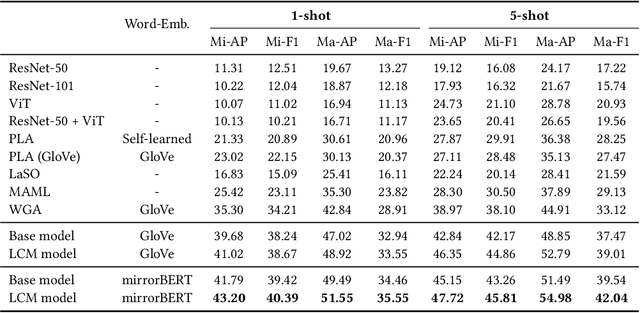

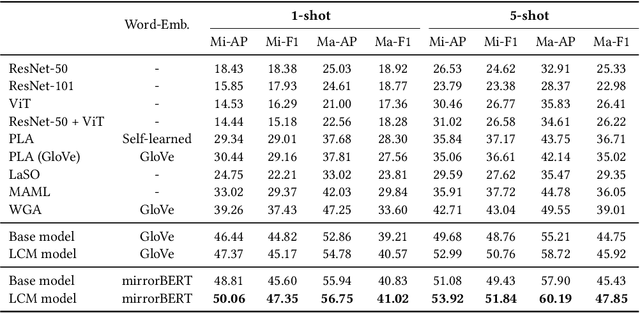
Abstract:The aim of multi-label few-shot image classification (ML-FSIC) is to assign semantic labels to images, in settings where only a small number of training examples are available for each label. A key feature of the multi-label setting is that images often have several labels, which typically refer to objects appearing in different regions of the image. When estimating label prototypes, in a metric-based setting, it is thus important to determine which regions are relevant for which labels, but the limited amount of training data and the noisy nature of local features make this highly challenging. As a solution, we propose a strategy in which label prototypes are gradually refined. First, we initialize the prototypes using word embeddings, which allows us to leverage prior knowledge about the meaning of the labels. Second, taking advantage of these initial prototypes, we then use a Loss Change Measurement~(LCM) strategy to select the local features from the training images (i.e.\ the support set) that are most likely to be representative of a given label. Third, we construct the final prototype of the label by aggregating these representative local features using a multi-modal cross-interaction mechanism, which again relies on the initial word embedding-based prototypes. Experiments on COCO, PASCAL VOC, NUS-WIDE, and iMaterialist show that our model substantially improves the current state-of-the-art.
UniGraspTransformer: Simplified Policy Distillation for Scalable Dexterous Robotic Grasping
Dec 03, 2024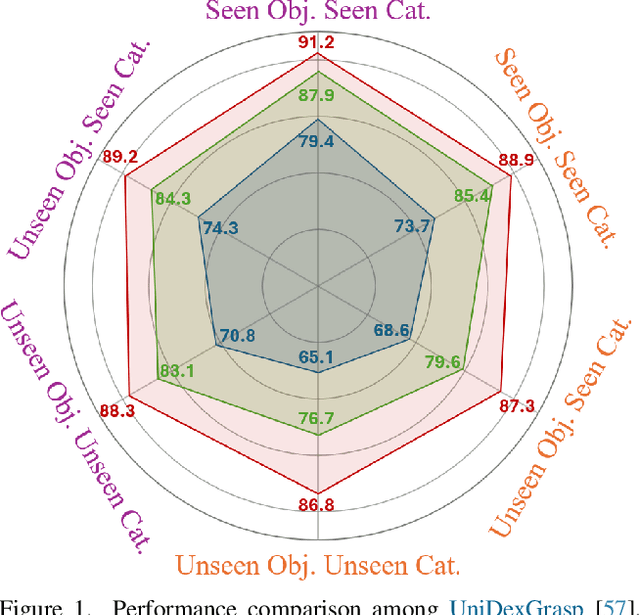

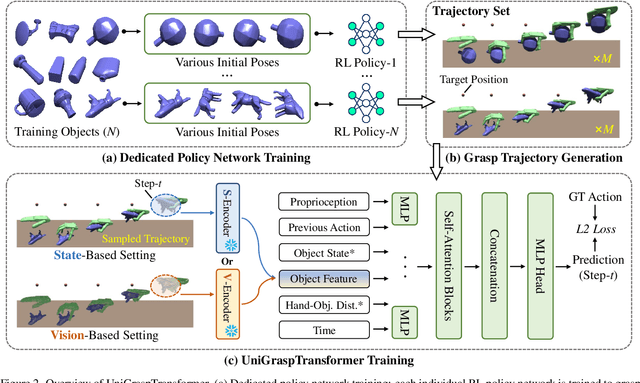

Abstract:We introduce UniGraspTransformer, a universal Transformer-based network for dexterous robotic grasping that simplifies training while enhancing scalability and performance. Unlike prior methods such as UniDexGrasp++, which require complex, multi-step training pipelines, UniGraspTransformer follows a streamlined process: first, dedicated policy networks are trained for individual objects using reinforcement learning to generate successful grasp trajectories; then, these trajectories are distilled into a single, universal network. Our approach enables UniGraspTransformer to scale effectively, incorporating up to 12 self-attention blocks for handling thousands of objects with diverse poses. Additionally, it generalizes well to both idealized and real-world inputs, evaluated in state-based and vision-based settings. Notably, UniGraspTransformer generates a broader range of grasping poses for objects in various shapes and orientations, resulting in more diverse grasp strategies. Experimental results demonstrate significant improvements over state-of-the-art, UniDexGrasp++, across various object categories, achieving success rate gains of 3.5%, 7.7%, and 10.1% on seen objects, unseen objects within seen categories, and completely unseen objects, respectively, in the vision-based setting. Project page: https://dexhand.github.io/UniGraspTransformer.
CogACT: A Foundational Vision-Language-Action Model for Synergizing Cognition and Action in Robotic Manipulation
Nov 29, 2024



Abstract:The advancement of large Vision-Language-Action (VLA) models has significantly improved robotic manipulation in terms of language-guided task execution and generalization to unseen scenarios. While existing VLAs adapted from pretrained large Vision-Language-Models (VLM) have demonstrated promising generalizability, their task performance is still unsatisfactory as indicated by the low tasks success rates in different environments. In this paper, we present a new advanced VLA architecture derived from VLM. Unlike previous works that directly repurpose VLM for action prediction by simple action quantization, we propose a omponentized VLA architecture that has a specialized action module conditioned on VLM output. We systematically study the design of the action module and demonstrates the strong performance enhancement with diffusion action transformers for action sequence modeling, as well as their favorable scaling behaviors. We also conduct comprehensive experiments and ablation studies to evaluate the efficacy of our models with varied designs. The evaluation on 5 robot embodiments in simulation and real work shows that our model not only significantly surpasses existing VLAs in task performance and but also exhibits remarkable adaptation to new robots and generalization to unseen objects and backgrounds. It exceeds the average success rates of OpenVLA which has similar model size (7B) with ours by over 35% in simulated evaluation and 55% in real robot experiments. It also outperforms the large RT-2-X model (55B) by 18% absolute success rates in simulation. Code and models can be found on our project page (https://cogact.github.io/).
Expressive and Generalizable Low-rank Adaptation for Large Models via Slow Cascaded Learning
Jul 01, 2024



Abstract:Efficient fine-tuning plays a fundamental role in modern large models, with low-rank adaptation emerging as a particularly promising approach. However, the existing variants of LoRA are hampered by limited expressiveness, a tendency to overfit, and sensitivity to hyperparameter settings. This paper presents LoRA Slow Cascade Learning (LoRASC), an innovative technique designed to enhance LoRA's expressiveness and generalization capabilities while preserving its training efficiency. Our approach augments expressiveness through a cascaded learning strategy that enables a mixture-of-low-rank adaptation, thereby increasing the model's ability to capture complex patterns. Additionally, we introduce a slow-fast update mechanism and cascading noisy tuning to bolster generalization. The extensive experiments on various language and vision datasets, as well as robustness benchmarks, demonstrate that the proposed method not only significantly outperforms existing baselines, but also mitigates overfitting, enhances model stability, and improves OOD robustness. Code will be release in https://github.com/microsoft/LoRASC very soon.
Revisiting Referring Expression Comprehension Evaluation in the Era of Large Multimodal Models
Jun 24, 2024
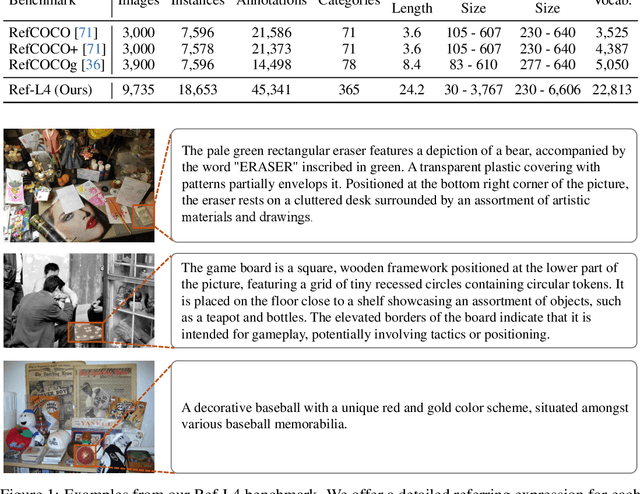

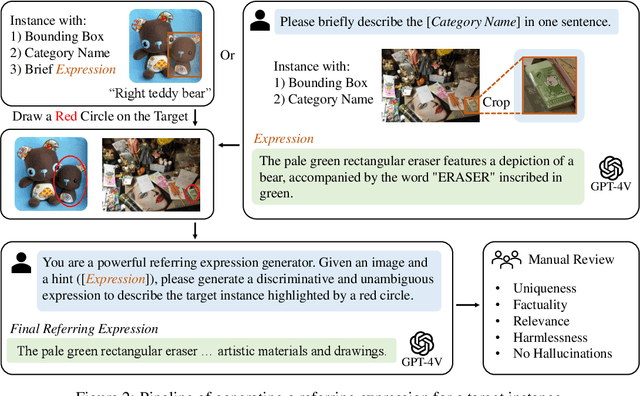
Abstract:Referring expression comprehension (REC) involves localizing a target instance based on a textual description. Recent advancements in REC have been driven by large multimodal models (LMMs) like CogVLM, which achieved 92.44% accuracy on RefCOCO. However, this study questions whether existing benchmarks such as RefCOCO, RefCOCO+, and RefCOCOg, capture LMMs' comprehensive capabilities. We begin with a manual examination of these benchmarks, revealing high labeling error rates: 14% in RefCOCO, 24% in RefCOCO+, and 5% in RefCOCOg, which undermines the authenticity of evaluations. We address this by excluding problematic instances and reevaluating several LMMs capable of handling the REC task, showing significant accuracy improvements, thus highlighting the impact of benchmark noise. In response, we introduce Ref-L4, a comprehensive REC benchmark, specifically designed to evaluate modern REC models. Ref-L4 is distinguished by four key features: 1) a substantial sample size with 45,341 annotations; 2) a diverse range of object categories with 365 distinct types and varying instance scales from 30 to 3,767; 3) lengthy referring expressions averaging 24.2 words; and 4) an extensive vocabulary comprising 22,813 unique words. We evaluate a total of 24 large models on Ref-L4 and provide valuable insights. The cleaned versions of RefCOCO, RefCOCO+, and RefCOCOg, as well as our Ref-L4 benchmark and evaluation code, are available at https://github.com/JierunChen/Ref-L4.
EAGLE-2: Faster Inference of Language Models with Dynamic Draft Trees
Jun 24, 2024Abstract:Inference with modern Large Language Models (LLMs) is expensive and time-consuming, and speculative sampling has proven to be an effective solution. Most speculative sampling methods such as EAGLE use a static draft tree, implicitly assuming that the acceptance rate of draft tokens depends only on their position. Interestingly, we found that the acceptance rate of draft tokens is also context-dependent. In this paper, building upon EAGLE, we propose EAGLE-2, which introduces a new technique of context-aware dynamic draft tree into drafting modeling. This improvement leverages the fact that the draft model of EAGLE is well-calibrated: the confidence scores from the draft model approximate acceptance rates with small errors. We conducted extensive evaluations on three series of LLMs and six tasks, with EAGLE-2 achieving speedup ratios 3.05x-4.26x, which is 20%-40% faster than EAGLE-1. EAGLE-2 also ensures that the distribution of the generated text remains unchanged, making it a lossless acceleration algorithm.
Scaling the Codebook Size of VQGAN to 100,000 with a Utilization Rate of 99%
Jun 17, 2024
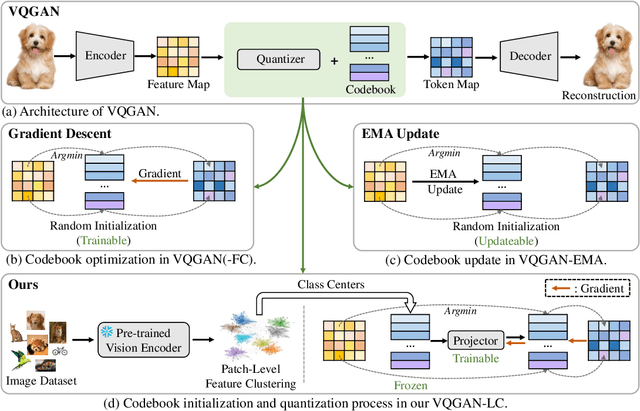
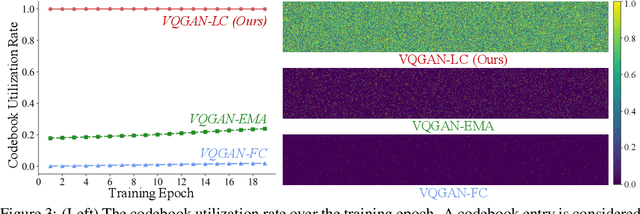
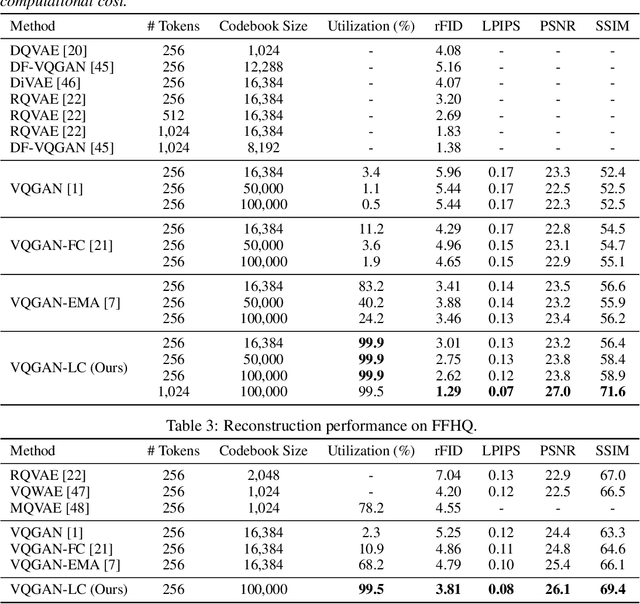
Abstract:In the realm of image quantization exemplified by VQGAN, the process encodes images into discrete tokens drawn from a codebook with a predefined size. Recent advancements, particularly with LLAMA 3, reveal that enlarging the codebook significantly enhances model performance. However, VQGAN and its derivatives, such as VQGAN-FC (Factorized Codes) and VQGAN-EMA, continue to grapple with challenges related to expanding the codebook size and enhancing codebook utilization. For instance, VQGAN-FC is restricted to learning a codebook with a maximum size of 16,384, maintaining a typically low utilization rate of less than 12% on ImageNet. In this work, we propose a novel image quantization model named VQGAN-LC (Large Codebook), which extends the codebook size to 100,000, achieving an utilization rate exceeding 99%. Unlike previous methods that optimize each codebook entry, our approach begins with a codebook initialized with 100,000 features extracted by a pre-trained vision encoder. Optimization then focuses on training a projector that aligns the entire codebook with the feature distributions of the encoder in VQGAN-LC. We demonstrate the superior performance of our model over its counterparts across a variety of tasks, including image reconstruction, image classification, auto-regressive image generation using GPT, and image creation with diffusion- and flow-based generative models. Code and models are available at https://github.com/zh460045050/VQGAN-LC.
 Add to Chrome
Add to Chrome Add to Firefox
Add to Firefox Add to Edge
Add to Edge